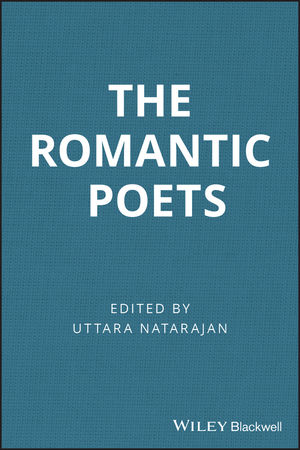The Romantic PoetsISBN: 978-0-631-22931-5
Hardcover
360 pages
November 2007, Wiley-Blackwell
 This is a Print-on-Demand title. It will be printed specifically to fill your order. Please allow an additional 10-15 days delivery time. The book is not returnable.
|
||||||
Introduction.
1. William Blake (1757–1827).
Critical History: From First Responses to Northrop Frye.
Extract from Northrop Frye, Fearful Symmetry: A Study of William Blake (1947).
Further reading.
Critical History: Historical and Political Readings.
Extract from David Erdman, Blake: Prophet against Empire (1954).
Further reading.
Critical History: To the Present.
Extract from V. A. De Luca, Words of Eternity: Blake and the Poetics of the.
Sublime (1991).
Further reading.
Useful editions.
Reference material.
Chapter notes.
2. William Wordsworth (1770–1850).
Critical History: The Contemporary Reception.
Extract from William Hazlitt, ‘Mr. Wordsworth’, in The Spirit of the Age.
(1825).
Further reading.
Critical History: Arnold to Hartman: From ‘Nature’ to ‘Vision’.
Extract from Geoffrey Hartman, Wordsworth’s Poetry 1787–1814 (1964).
Further reading.
Critical History: Historicizing Wordsworth.
Extract from Alan Liu, Wordsworth: The Sense of History (1989).
Further reading.
Critical History: To the Present.
Extract from David Bromwich, Disowned by Memory: Wordsworth’s Poetry.
of the 1790s (1998).
Further reading.
Useful editions.
Reference material.
Chapter notes.
3. Samuel Taylor Coleridge (1772–1834).
Critical History: From the 1790s to the 1930s.
Extract from J. L. Lowes, The Road to Xanadu (1927).
Further reading.
Critical History: Idealizing Coleridge.
Extract from John Beer, Coleridge the Visionary (1959).
Further reading.
Critical History: Deconstructing Coleridge.
Extract from J. J. McGann, ‘The Ancient Mariner: The Meaning of.
Meanings’ in The Beauty of Inflections (1985).
Further reading.
Critical History: To the Present.
Extract from Seamus Perry, Coleridge and the Uses of Division (1999).
Further reading.
Useful editions.
Reference material.
Chapter notes.
4. George Gordon, Lord Byron (1788–1824).
Critical History: From Contemporary Responses to Victorian Readings.
Extract from Joseph Mazzini, ‘On Byron and Goethe’ (1839).
Further reading.
Critical History: The Early Twentieth Century.
Extract from T. S. Eliot, ‘Byron’ (1937).
Further reading.
Critical History: Canonical Byron: The 1960s and Onwards.
Extract from J. J. McGann, Fiery Dust: Byron’s Poetic Development (1968).
Further reading.
Critical History: Byron and Politics.
Extract from Jerome Christensen, Lord Byron’s Strength: Romantic.
Writing and Commercial Society (1993).
Further reading.
Useful editions.
Reference material.
Chapter notes.
5. Percy Bysshe Shelley (1792–1822).
Critical History: From Contemporary Responses to the Twentieth Century.
Extract from C. E. Pulos, The Deep Truth: A Study of Shelley’s Scepticism.
(1954).
Further reading.
Critical History: Shelley, Scepticism and Idealism.
Extract from Earl Wasserman, Shelley: A Critical Reading (1971).
Further reading.
Critical History: Shelley and Socialism.
Extract from Timothy Clark, Embodying Revolution: The Figure of the.
Poet in Shelley (1989).
Further reading.
Useful editions.
Reference material.
Chapter notes.
6. John Keats (1795–1821).
Critical History: The Contemporary Reception.
Extract from J. G. Lockhart (‘Z’), ‘The Cockney School of Poetry’ (No. 4) in Blackwood’s Edinburgh Magazine (1818).
Further reading.
Critical History: Keats Canonized: The Victorian Period to the Twentieth Century.
Extract from Walter Jackson Bate, John Keats (1963).
Further reading.
Critical History: Class, Gender and Politics: Keats’s Anxiety.
Extract from Marjorie Levinson, Keats’s Life of Allegory: The Origins of a.
Style (1988).
Further reading.
Critical History: History and Politics: Keats’s Radicalism.
Extract from Nicholas Roe, John Keats and the Culture of Dissent (1997).
Further reading.
Useful editions.
Reference material.
Chapter notes.
7. An Expanding Canon.
Critical History: John Clare (1793–1864).
Extract from John Barrell, ‘Being is Perceiving: James Thomson and John.
Clare’ in Poetry, Language, and Politics (1988).
Further reading.
Useful editions.
Critical History: Romantic Women Poets.
Extract from Stuart Curran, ‘Romantic Poetry: The I Altered’ in Romanticism and Feminism, ed. Anne Mellor (1988).
Further reading.
Useful editions.
Reference material.
Chapter notes.
Index



